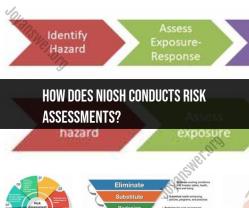How does NIOSH conducts risk assessments?
The National Institute for Occupational Safety and Health (NIOSH) conducts risk assessments to evaluate workplace hazards and risks to worker health and safety. NIOSH uses a systematic approach to identify, assess, and control occupational risks. Here's an overview of how NIOSH conducts risk assessments:
Hazard Identification:
- NIOSH begins by identifying potential hazards in the workplace. Hazards can include chemical exposures, physical hazards, ergonomic stressors, biological agents, and psychosocial factors.
Exposure Assessment:
- NIOSH assesses the extent and nature of workers' exposure to identified hazards. This may involve measuring chemical concentrations, noise levels, ergonomic stressors, or other relevant factors.
- Exposure assessments may include air sampling, personal monitoring, or data collection through surveys and interviews.
Risk Characterization:
- After identifying hazards and assessing exposure, NIOSH characterizes the risks associated with those hazards. This involves evaluating the potential health effects of exposure and the likelihood of those effects occurring.
- Risk characterization considers factors such as exposure duration, intensity, and frequency.
Health Effects Evaluation:
- NIOSH reviews scientific literature and conducts research to understand the health effects associated with specific hazards. This may involve epidemiological studies, toxicological research, and health impact assessments.
Development of Recommendations:
- Based on the risk assessment findings, NIOSH develops recommendations to control or mitigate the identified hazards.
- Recommendations may include engineering controls, administrative measures, personal protective equipment (PPE), and changes in work practices.
Guidelines and Standards:
- NIOSH's risk assessments contribute to the development of occupational safety and health guidelines and standards. These guidelines may be adopted by regulatory agencies such as the Occupational Safety and Health Administration (OSHA).
Technical Assistance and Training:
- NIOSH provides technical assistance and training to employers, workers, and other stakeholders to help them implement recommended controls and improve workplace safety.
Research and Surveillance:
- NIOSH conducts ongoing research and surveillance to stay updated on emerging workplace hazards and trends. This information informs risk assessments and helps identify new risks.
Collaboration and Communication:
- NIOSH collaborates with various organizations, including government agencies, industry groups, labor unions, and academic institutions, to share knowledge and expertise in occupational safety and health.
- NIOSH communicates risk assessment findings through publications, reports, guidelines, and educational materials.
Monitoring and Evaluation:
- NIOSH continually monitors the effectiveness of its recommendations and interventions in reducing workplace hazards and improving worker safety.
- Evaluation involves reviewing injury and illness data, conducting follow-up assessments, and making adjustments as needed.
Overall, NIOSH's risk assessments aim to protect the health and well-being of workers by identifying and addressing occupational hazards. By conducting thorough assessments and providing evidence-based recommendations, NIOSH contributes to safer and healthier workplaces across various industries.
How NIOSH Assesses Occupational Health and Safety Risks
The National Institute for Occupational Safety and Health (NIOSH) assesses occupational health and safety risks using a variety of methods, including:
- Literature reviews: NIOSH reviews the scientific literature to identify potential hazards and to assess the risks associated with those hazards.
- Workplace surveys: NIOSH conducts workplace surveys to assess the exposure of workers to hazardous substances and to identify potential hazards.
- Exposure assessments: NIOSH uses a variety of methods to assess the exposure of workers to hazardous substances. These methods include air monitoring, biological monitoring, and surface sampling.
- Epidemiological studies: NIOSH conducts epidemiological studies to identify the associations between occupational exposures and health outcomes.
NIOSH Hazard Evaluation Methods and Exposure Limits
NIOSH uses a variety of hazard evaluation methods to assess the risks associated with occupational hazards. These methods include:
- Hazard identification: NIOSH identifies potential hazards by reviewing the scientific literature, conducting workplace surveys, and assessing exposure data.
- Dose-response assessment: NIOSH assesses the relationship between the dose of a hazard and the risk of adverse health effects.
- Risk characterization: NIOSH integrates the information from the hazard identification and dose-response assessment to characterize the risk of adverse health effects from exposure to a hazard.
NIOSH also establishes recommended exposure limits (RELs) for occupational hazards. RELs are non-regulatory guidelines that NIOSH recommends to employers to protect workers from adverse health effects.
NIOSH Recommendations for Controlling Workplace Risks
NIOSH recommends a variety of methods for controlling workplace risks, including:
- Elimination: The best way to control a risk is to eliminate it altogether. If a hazard cannot be eliminated, it is important to reduce the exposure of workers to the hazard as much as possible.
- Engineering controls: Engineering controls are physical changes to the workplace that reduce the exposure of workers to hazards. Examples of engineering controls include ventilation systems, machine guarding, and noise barriers.
- Administrative controls: Administrative controls are changes to work procedures or policies that reduce the exposure of workers to hazards. Examples of administrative controls include work rotation, training, and medical surveillance.
- Personal protective equipment (PPE): PPE is equipment that workers wear to protect themselves from hazards. Examples of PPE include respirators, gloves, and safety glasses.
NIOSH also provides a variety of resources to help employers and workers identify and control workplace risks. These resources include publications, training programs, and technical assistance.
By using the information and resources provided by NIOSH, employers and workers can help to protect workers from occupational health and safety risks.


